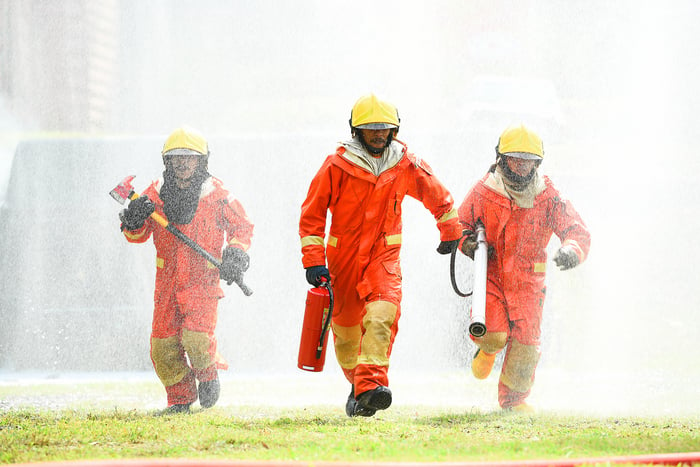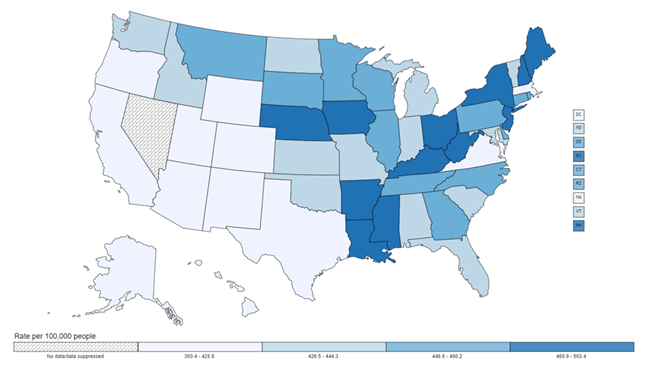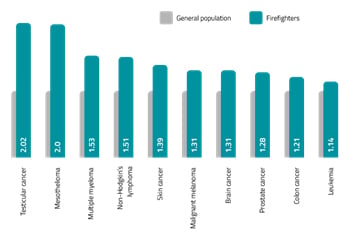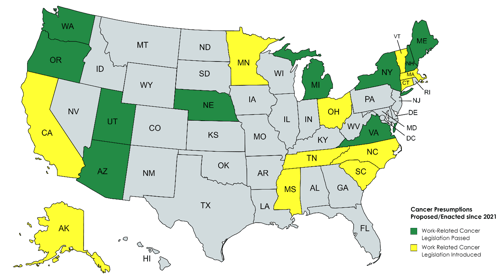
Pharmacy Choice White Paper
The effects of Covid-19 have shifted workers’ compensation to focus in on occupational illnesses and diseases, even cancer. While cancer presumptions have been on the books for some states, over 20 states modified their presumptions since the start of 2021. Traditionally cancer presumptions are exclusively for firefighters as their risk of becoming ill is significantly higher than most occupations. However, legislators are turning their attention to modifying or expanding eligibility to other occupations particularly those in the first responder category as new research continues to develop. For a number of statehouses, the pandemic exposed significant coverage gaps in workers’ compensation that legislators are increasingly looking to address.
Cancer is the second leadingi cause of death in the U.S., just behind heart disease, according to the Center for Disease Control (CDC). Since 2001, innovative cancer treatments improved outcomes, decreasing cancer death rates in the last 20 years by twenty-seven percent (27%). Risk factors for developing cancer vary but include where you live, how you eat, age, genetics, lifestyle activity, and what you do for work. These factors differ significantly from person to person and require a largely individualized approach for assessment.
Overall, cancer tends to be more prevalent in men, with a 1 in 2 chance of developing cancer in their lifetime compared to 1 in 3 for women. However, fatality rates for men and women are about the same at 1 in 5, according to the American Cancer Societyii. While cancer risk varies from person to person, it is more common in certain occupations.
Rate of New Cancers in the United States, 2018 All Types of Cancer, All Ages and Ethnicities, Male and Female
CDC Cancer Map 2018

Occupationsiii with recorded higher risksiv of cancers include:
- Airplane Pilots
- Construction Workers
- Mine Workers
- Power Plant Workers
- Nail salon Workers
- Agriculture Workers
- Firefighters
- Police Officers
- Military Members/Veterans
- Rubber Manufacturers (i.e. tires)
- Morticians working with formaldehyde
- Careers with prolonged sitting
Chemical exposure, being in the sun for too long, asbestos, and similar risks can all contribute to a cancer diagnosis, according to Occupational Safety & Health Administration (OSHA), the International Agency for Research on Cancer, The World Health Organization, and the National Institute for Occupational Safety & Health (NIOSH). The American Journal of Epidemiologyv says that even white-collar office jobs with prolonged sitting raise the chances of developing cancer as there is a higher likelihood of increased blood pressure, blood sugar, cholesterol, and weight gain.
In response to certain occupational conditions furthering the risk of cancer, several protections and regulations were put in place. Most of these protections come from federal legislation, such as the Toxic Substances Control Act modified by the Environmental Protection Agencyvi (EPA) and OSHA's permissible exposure limits (PEL's)vii. Rules and policies by each agency significantly influence workplace safety standards nationally. However, states propped up their own protective measures as well.
One of the more comprehensive methods to protect workers with significant risk due to their job duties is through workers' compensation protections on the federal and state levels. Nearly every state permits a workers’ compensation presumption for cancer and chronic illnesses or a similar alternative program. However, the degree of coverage can vary greatly by state, and the burden of proof may be more challenging to demonstrate in certain states. Occupations also significantly differ in workers' compensation coverage for cancer, with just a few states allowing cancer presumption for professions outside of first responder groups. Nonetheless, legislative leaders on both sides of the aisle supported presumptions/protections in some fashion, particularly for firefighters, police, and paramedics.
First Responders
Workers' compensation presumptions for first responders garnered significant attention following the 9/11 attacks and through the thick of the covid-19 pandemic. Both circumstances demonstrated the importance first responders have within society and the essential services they provide amid potentially dangerous circumstances. While many 9/11 firefighters, medics, and police officers suffered from significant scrapes, cuts, bruises, smoke inhalation, and similar injuries, for many, the injuries they incurred did not end on that day.
Of the 82,818 first responders registered with the CDC's 9/11 World Trade Center Health programviii, approximately 15,500+ subsequently developed a form of cancer. These numbers reflect the 9/11 attacks in New York City, The Pentagon, and the crash site near Shanksville, PA. The most common cancers developed amongst this group include non-melanoma skin, prostate, breast, melanoma, lymphoma, thyroid, and lung cancers. Male first responders from 9/11 overwhelmingly present a much higher risk of developing cancer or illness. 9/11 first responders specifically saw a 25% increased risk of prostate cancer, 50% in thyroid cancer, and a 41% higher risk of developing leukemia compared to the general population. Although the 9/11 first responders saw higher cancer rates because of the nature of their work, they were also 35% moreix likely to survive than the general population. Researchers from the Albert Einstein College of Medicine partially attributex this decreased mortality rate to high-quality care from federal and state programs, including workers' compensation.
National and international data consistently show first responders are more likely to develop cancer than other occupations. These findings are especially the case for firefighters who constantly engage with burning fumes and chemical substances. Today, firefighters' leading cause of death in the United States is cancerxi. A CDC-backed studyxii released in 2017 shows that cancer rates among firefighters were 10% higher than the general population and 14% higher when it comes to cancer-related deaths. The International Association of Firefighters (IAFF) says that 66% of career firefightersxiii between 2002-2019 passed away from cancer. IAFF officials note that most cancers are related to the respiratory tract (lung, mesothelioma), gestational system, and kidneys. Firefighters experience two times the risk of developing mesothelioma and take on a 50%+ risk than the general population when it comes to being diagnosed with multiple myeloma, non-Hodgkin's lymphoma, and skin cancer. Higher incidences of brain, prostate, and colon cancers are also observed. Today only two statesxiv, Delaware and South Carolina, lack significant cancer coverage for firefighters.
Firefighter Cancer Support Network 2020

Police officers and EMT’s while reporting lower rates of cancer than firefighters, were more at risk for certain cancers. A comprehensive study by the National Institute for Occupational Safety and Health (NIOSH) foundxv that police officers between 1976-2006 in the Northeast U.S. region saw a greater risk of developing Hodgkin’s lymphoma and brain cancer. Other studies In Washingtonxvi, Oregon, and New Jerseyxvii confirmed similar findings of increased cancer risks. Initial data from the Journal of Emergency Medical Servicesviii also display higher cancer diagnoses for paramedics.
Among The States
Several states implemented changes or sought to review existing cancer coverage in response to the covid-19 pandemic’s effect on front-line workers. In 2021, Arizona (SB1451), Maine (LD213), Michigan (H4171,4172), Nebraska (LB432), New Hampshire (HB385), New York (S4408), and in 2022 Oregon (H4113), Utah (HB287), Virginia (SB562/HB1042) & Washington (SB5890) passed cancer presumption alterations in their respective states. States such as AK, CA, MA, ME, MN, NC, OH, SC, TN, VA, VT, WV also proposed changes to their cancer presumptions laws since 2021. Over 20 states proposed or enacted changes to their cancer presumption laws in the last two years.

The modifications to state statutes vary in severity and groups covered for each individual state. While some states may explicitly list cancers eligible for a presumption, others may be broader in their legislative language to be more inclusive of rarer forms of cancer. Most of the time the legislature will formally pass cancer presumption changes. Nevertheless, some states will grant their state agencies the authority to create rules and regulate what cancers and occupations are eligible for coverage. States may even alter their statutes/regulatory rules in ways to accommodate their respective workforces. For example, presumption laws on the federal level and on the west coast look to improve firefighter benefits as wildfire issues continue to trouble the region. This precedent can also be observed in states within Appalachiaxix, where coal mining leads to increased rates of black lung disease.
Of the states that enacted presumption laws recently, New York, Michigan, and Washington added occupations eligible to their state presumption lists to safeguard benefit coverage. New York's enacted bill provides extended coverage to airport firefighters. On the other hand, Michigan added forest fire officers and rescue crews to its workers' compensation cancer eligibility. Washington state's new law uniquely enhanced benefits for workers handling radiologically hazardous materials, expanding coverage to workforces outside of the first responder category.
Federal Challenge to Federal Nuclear Site Cancer Presumption
The state of Washington previously passed a bill in 2018 to provide cancer coverage to workers at the Hanford Federal Nuclear site, which the federal government is currently challenging before the Supreme Court. The challenge is not because of a disagreement over whether workers' compensation protections should cover workers at the site but if the state holds the authority to enforce state workers' compensation laws on a federal site. Arguments for the case are currently being heard before the Supreme Court, where it is likely to favor the federal government's authority. Washington's HB5890 passed this year and signed into law is an attempt not to overstep the federal government's authority while also providing cancer coverage to workers handling radiologic waste in the state.
Focus on Female Firefighters' Health
States such as Arizona, Oregon, and Maine's enacted changes show an increased emphasis on female firefighters' health. These states added female-related cancers to the state's presumption list to ensure equity in a historically male-dominated occupation. Arizona added ovarian and breast cancers to their state presumption list. Whereas Maine and Oregon added gynecological-related cancers to their presumption list, making their presumptions more comprehensive by covering female reproductive cancers in a broader sense. Currently, it is estimated there are approximately 6,200xx career female firefighters throughout the U.S.
Volunteer Firefighters
Unknown to most, volunteer firefighters make up most firefighters in the U.S. It is approximated that nearly 70%xxi of U.S. firefighters are volunteers. Volunteers are usually not paid, or if they are, it is in the form of a stipend or commuting expenses. Although most states have presumptions for firefighters, volunteers are commonly excluded from these protections. With most firefighters in the country classified as volunteers, this lack of proper coverage is concerning, particularly for states with smaller budgets or within wide rural settings where such communities greatly depend on these services. This year the state of Utah, via HB287, enacted legislation to extend workers' compensation coverage to firefighters within the volunteer classification, which gives these volunteers critical protections while also assisting local departments with long-term retention and recruitment.
Restrictions/Exceptions
The majority of states emphasized the need to pass cancer presumption statutes to protect those facing a higher probability of a cancer diagnosis due to their occupational duties. Nonetheless, limitations and restrictions exist, such as filing deadlines, lifestyle practices, geographic constraints, and age requirements. These limitations can be seen with recently enacted legislation in Virginia (S562), where lawmakers agreed to bar claims for claimants with occupational diseases that are 65 years of age or older, regardless of the date of diagnosis, communication, or last injurious exposure in employment. Other state examples include:
 Arizona's (Title 23-901.01) cancer presumption for police officers, while more comprehensive than most states, is similar to Virginia's in the fact that the state does not allow claimants with occupational diseases over the age of 65. Arizona police officers must also be assigned to 'hazardous' duty for at least five years to become eligible for the state's cancer presumption. This definition can be problematic for officers as hazardous could be interpreted in a fashion that could limit the number of claimants eligible. State statutes define hazardous duty as including regular assignment to "special operations, special weapons, and tactics, explosive ordinance disposal or hazardous materials response unit."
Arizona's (Title 23-901.01) cancer presumption for police officers, while more comprehensive than most states, is similar to Virginia's in the fact that the state does not allow claimants with occupational diseases over the age of 65. Arizona police officers must also be assigned to 'hazardous' duty for at least five years to become eligible for the state's cancer presumption. This definition can be problematic for officers as hazardous could be interpreted in a fashion that could limit the number of claimants eligible. State statutes define hazardous duty as including regular assignment to "special operations, special weapons, and tactics, explosive ordinance disposal or hazardous materials response unit."
 Texas, via SB2551, which became law in 2019, added specific types of cancer to its statutes, including colon, stomach, and prostate cancers. However, the bill only applies to active firefighters. This change excludes retired firefighters who, accompanied by age, may have a higher risk of developing cancer. It also contains provisions that mandate firefighters in order to qualify for benefits, must not be a smoker; the firefighter's partner, if applicable, must also be a non-smoker.
Texas, via SB2551, which became law in 2019, added specific types of cancer to its statutes, including colon, stomach, and prostate cancers. However, the bill only applies to active firefighters. This change excludes retired firefighters who, accompanied by age, may have a higher risk of developing cancer. It also contains provisions that mandate firefighters in order to qualify for benefits, must not be a smoker; the firefighter's partner, if applicable, must also be a non-smoker.
 Wisconsin (Chapter 891-495) statutes require ten years at minimum service for firefighters to become qualified for benefits, which is a more extended timeframe than other states with existing presumptions. Like Texas, Wisconsin denies claims to those that smoke cigarettes. However, the state lists cancers with labels such as digestive or affecting the central nervous system, which can allow for more cancers to qualify rather than listing each individual cancer.
Wisconsin (Chapter 891-495) statutes require ten years at minimum service for firefighters to become qualified for benefits, which is a more extended timeframe than other states with existing presumptions. Like Texas, Wisconsin denies claims to those that smoke cigarettes. However, the state lists cancers with labels such as digestive or affecting the central nervous system, which can allow for more cancers to qualify rather than listing each individual cancer.
 Maine (Title 39A Chapter 7 Section 328) limits claims for retired firefighters after ten years since their last active service. The state's presumption also excludes claims to injured workers over the age of 70. Maine's presumption is also slightly limited in the number of cancers eligible for benefits.
Maine (Title 39A Chapter 7 Section 328) limits claims for retired firefighters after ten years since their last active service. The state's presumption also excludes claims to injured workers over the age of 70. Maine's presumption is also slightly limited in the number of cancers eligible for benefits.
Judicial Implications
While nearly all states modified their statutes or regulatory procedures to alter occupationally related cancer claims, the presumptions are nearly always rebuttable. If a claim is contested, this can put a wrench in the injured worker's ability to receive benefits. Most presumptions being for first responders, these occupations usually experience significant denial rates. For example, Ohio reported that nearly half of occupational disease claims were denied or disputed. Since 2012, Texas experienced a much higher denial rate, with 9 out of 10 firefighters being refused benefits. Denial of cancer coverage, even with a presumption, is common in workers' compensation as many municipalities and employers who contest injured workers' claims say it is difficult to relate a cancer diagnosis to specific work-related duties. This leaves the courts as a crucial element in how presumptions are interpreted and enforced.
 Arizona - Aguirre v. Industrial Commission of Arizona (ICA) gave an Arizona firefighter, Gilbert Aguirre, a second chance to claim workers' compensation. Aguirre, a 20-year veteran firefighter for the city of Goodyear fire department, claimed workers' compensation after his leukemia diagnosis. The insurance company for the city denied the claim, which Aguirre contested. During a hearing before the ICA, both Aguirre and the insurance company put forth medical experts who spoke on how the cancer is and isn't related to Aguirre's duties as a firefighter. ICA held that Aguirre could not proceed to claim benefits as his claim lacked evidence that his cancer is closely related to his occupational requirements. Nevertheless, Aguirre refuted this conclusion, and the Arizona Court of Appeals agreed with Aguirre that the ICA did not hold enough "specific evidence" to deny his claim. This ruling allowed Aguirre to re-file for workers' compensation. In 2021, the state legislature enhanced firefighter cancer workers' compensation language via SB1451 to ensure more claims were accepted.
Arizona - Aguirre v. Industrial Commission of Arizona (ICA) gave an Arizona firefighter, Gilbert Aguirre, a second chance to claim workers' compensation. Aguirre, a 20-year veteran firefighter for the city of Goodyear fire department, claimed workers' compensation after his leukemia diagnosis. The insurance company for the city denied the claim, which Aguirre contested. During a hearing before the ICA, both Aguirre and the insurance company put forth medical experts who spoke on how the cancer is and isn't related to Aguirre's duties as a firefighter. ICA held that Aguirre could not proceed to claim benefits as his claim lacked evidence that his cancer is closely related to his occupational requirements. Nevertheless, Aguirre refuted this conclusion, and the Arizona Court of Appeals agreed with Aguirre that the ICA did not hold enough "specific evidence" to deny his claim. This ruling allowed Aguirre to re-file for workers' compensation. In 2021, the state legislature enhanced firefighter cancer workers' compensation language via SB1451 to ensure more claims were accepted.
 Pennsylvania – City of Philadelphia Fire Department v. Sladek affirmed that an injured firefighter need only produce evidence that it is possible that the carcinogen (fumes, smoke, exposure) in question is the cause of the type of cancer from which he or she suffers. Once the firefighter-claimant shows this casual relationship, the burden of proof switches to the employer, who then must show a specific, non-firefighting cause of the claimant's cancer. From there the court concluded that it is no longer sufficient for the employer's medical expert witness to simply attest that the firefighter's cancer may or may not possibly be caused by a Group 1 carcinogen. This more specified requirement works in favor of injured workers, pushing the burden of proof back to the employer to show particular causation that is non-work related. However, the court does say that the firefighter's claim must be in accordance with the Frye standard under rule 702 of Pennsylvania's Evidence Rules. This standard entails that the scientific community generally accepts the firefighters' medical evidence claim before it is considered admissible.
Pennsylvania – City of Philadelphia Fire Department v. Sladek affirmed that an injured firefighter need only produce evidence that it is possible that the carcinogen (fumes, smoke, exposure) in question is the cause of the type of cancer from which he or she suffers. Once the firefighter-claimant shows this casual relationship, the burden of proof switches to the employer, who then must show a specific, non-firefighting cause of the claimant's cancer. From there the court concluded that it is no longer sufficient for the employer's medical expert witness to simply attest that the firefighter's cancer may or may not possibly be caused by a Group 1 carcinogen. This more specified requirement works in favor of injured workers, pushing the burden of proof back to the employer to show particular causation that is non-work related. However, the court does say that the firefighter's claim must be in accordance with the Frye standard under rule 702 of Pennsylvania's Evidence Rules. This standard entails that the scientific community generally accepts the firefighters' medical evidence claim before it is considered admissible.
![]() Rhode Island – Lang v. Municipal Employees Retirement System established that existing state statutes did in fact, not have a conclusive cancer presumption for state firefighters. Kevin Lang, a 16-year veteran of the city of Cranston fire department, applied for benefits after his colon cancer diagnosis in 2014. The Municipal Employee's Retirement System denied his case as he could not show that his cancer "arose out of and in the course of employment", meaning Lang could not prove his cancer is connected directly because of his occupational duties as a firefighter. In response to the decision, Lang argued that state statutes included a presumption that presumed all cancers contracted by firefighters were work-related. Although the appellate court held in favor of Lang, the Municipal Employees Retirement System contested the manner bringing it to the state supreme court, leading to a fractured decision. The high court acknowledged that firefighters take on more health risks for their job, which is more likely than others to lead to higher cancer rates. However, justices disagreed that state statutes include a conclusive presumption for firefighters that all cancers developed are related to their work. State law deems occupational cancers "as a "a cancer arising out of his or her employment as a firefighter, due to injury from exposures to smoke, fumes, or carcinogenic, poisonous, toxic, or chemical substances while in the performance of active duty in the fire department." Justices said that while protections for firefighters exist, they believed the legislature "intended that an occupational cancer must be proven before a firefighter is entitled to receive occupational cancer disability benefits." The court's decision reversed the initial conclusion in favor of Lang, citing its belief that state laws regarding cancer benefits for firefighters were not a formal presumption. Thus, firefighters seeking cancer benefits must accurately prove a more than a casual connection between their work-related duties and their specific cancer. In 2020, the state legislature passed a conclusive presumption for firefighters in response to the court decision.
Rhode Island – Lang v. Municipal Employees Retirement System established that existing state statutes did in fact, not have a conclusive cancer presumption for state firefighters. Kevin Lang, a 16-year veteran of the city of Cranston fire department, applied for benefits after his colon cancer diagnosis in 2014. The Municipal Employee's Retirement System denied his case as he could not show that his cancer "arose out of and in the course of employment", meaning Lang could not prove his cancer is connected directly because of his occupational duties as a firefighter. In response to the decision, Lang argued that state statutes included a presumption that presumed all cancers contracted by firefighters were work-related. Although the appellate court held in favor of Lang, the Municipal Employees Retirement System contested the manner bringing it to the state supreme court, leading to a fractured decision. The high court acknowledged that firefighters take on more health risks for their job, which is more likely than others to lead to higher cancer rates. However, justices disagreed that state statutes include a conclusive presumption for firefighters that all cancers developed are related to their work. State law deems occupational cancers "as a "a cancer arising out of his or her employment as a firefighter, due to injury from exposures to smoke, fumes, or carcinogenic, poisonous, toxic, or chemical substances while in the performance of active duty in the fire department." Justices said that while protections for firefighters exist, they believed the legislature "intended that an occupational cancer must be proven before a firefighter is entitled to receive occupational cancer disability benefits." The court's decision reversed the initial conclusion in favor of Lang, citing its belief that state laws regarding cancer benefits for firefighters were not a formal presumption. Thus, firefighters seeking cancer benefits must accurately prove a more than a casual connection between their work-related duties and their specific cancer. In 2020, the state legislature passed a conclusive presumption for firefighters in response to the court decision.
Conclusion
Cancer presumptions can be incredibly intricate, depending on the state. While several statehouses upgraded or reconfigured their state regulations and statutes recently, many injured workers still fall through the cracks in the system. States may ease or modify requirements for injured workers with cancer to better qualify. However, lacking a formal state presumption makes proving a cancer claim exceedingly tumultuous particularly for injured first responders who encounter denials on a constant basis in numerous states. Convoluted statutory language can also put injured workers at the mercy of their respective state courts, potentially jeopardizing comprehensive cancer care for injured workers.
Although coverage ranges from state to state, progress on these issues is taking hold. Since the start of covid, over one third of the states modified or proposed changing their laws regarding cancer to protect first responders and certain high-risk occupations to ensure the workers' compensation benefits they require. There is also momentum to expand cancer presumptions to other occupations outside of first responders, as seen in Washington with nuclear waste management workers and in California, where a bill recently passed the state senate to provide cancer coverage to healthcare staff. With more in-depth research and increased attention to workplace safety, it is expected that more presumptions for first responders and high-risk jobs will continue to be proposed and discussed in statehouses in every area of the country. For now, injured workers that developed cancer and suspect it is work-related should closely review their state's existing cancer presumptions and look to relevant case law when filing a claim.
SOURCES
- Center for Disease Control (CDC). (2022, February 28). An Update on Cancer Deaths in the U.S. Retrieved from: https://www.cdc.gov/cancer/dcpc/research/update-on-cancer-deaths/index.htm#:~:text=Cancer%20was%20the%20second%20leading,females%20and%20317%2C731%20among%20males.
- American Cancer Society. (2022, May 12). Lifetime Risk of Developing or Dying of Cancer. Retrieved from: An Update on Cancer Deaths in thttps://www.cdc.gov/cancer/dcpc/research/update-on-cancer-deaths/index.htm#:~:text=Cancer%20was%20the%20second%20leading,females%20and%20317%2C731%20among%20males.he United States | CDC.
- Rana H. (2019 August 3). Which Professionals are Associated with Cancer Risk – Dana Farber Insitutue. Retrieved from: https://blog.dana-farber.org/insight/2019/08/which-professions-are-associated-with-cancer-risk/.
- McDowell E. (2020, July 27). 10 jobs that are linked to a higher risk of cancer - Business Insider. Retrieved from: https://www.businessinsider.com/jobs-linked-to-higher-risk-of-cancer-2019-7.
- Gapstur S., Maliniak M., Matthews C, & Rees-Punia E. (2018 October). Prolonged Leisure Time Spent Sitting in Relation to Cause-Specific Mortality in Large US Cohort – American Journal of Epidemiology. Retrieved from: https://academic.oup.com/aje/article/187/10/2151/5045572.
- S. Environmental Protection Agency. (2016 June 22). Summary of the Toxic Substances Control Act. Retrieved from: https://www.epa.gov/laws-regulations/summary-toxic-substances-control-act.
- S. Department of Labor. Permissible Exposure Limits - Annotated Tables. Retrieved from: https://www.osha.gov/annotated-pels.
- Center for Disease Control (CDC). (2022 March 31). World Trade Center Health Program. Retrieved from: https://www.cdc.gov/wtc/ataglance.html#enrollmentWTC.
- Allison A. & Martinez A. (2021 September 8). 9/11 First Responders Face a High Cancer Risk But Are Also More Likely To Survive- National Public Radio (NPR). Retrieved from: https://www.npr.org/sections/health-shots/2021/09/06/1034556283/a-study-says-9-11-first-responders-survive-cancers-at-higher-rates-why.
- Goldfarb D. & Zeig-Owens R. (2021 July 19). Cancer Survival Among World Trade Center Rescue and Recovery Workers: A Collaborative Cohort Study - American Journal of Industrial Medicine. Retrieved from: https://onlinelibrary.wiley.com/doi/10.1002/ajim.23278.
- National Institute for Occupational Safety & Health (NIOSH). (2021 January 8). Firefighter Cancer Awareness. Retrieved from: https://www.cdc.gov/niosh/newsroom/feature/firefighter-cancer-awareness.html
- Daniels R. (2017 May 10). Firefighter Cancer Rates – National Institute for Occupational Safety & Health (NIOSH). Retrieved from: https://blogs.cdc.gov/niosh-science-blog/2017/05/10/ff-cancer-facts/.
- Firefighter Cancer Support Network (FCSN) & International Association of Firefighters (IAFF). (2019). Latest Statistics Related to Cancer in Fire Service. Retrieved from: https://firefightercancersupport.org/resources/faq/.
- Yee G. (2019 October 29). SC is 1 of 2 states lacking firefighter cancer protection law. Here’s how that could change – The Post & Courier. Retrieved from: https://www.postandcourier.com/news/sc-is-of-states-lacking-firefighter-cancer-protection-law-here/article_f978636e-c45c-11e9-ac38-830c63cb2c82.html.
- Andrew M., Burchfiel C., Charles L., Gu J., & Volanti J. (2015 December 6). Cancer Incidence Among Police Officers in a U.S. Northeast Region – National Library of Medicine. Retrieved from: https://www.ncbi.nlm.nih.gov/pmc/articles/PMC4681507/.
- Morton W. & Marjanovic D. (1984). Leukemia incidence by occupation in the Portland-Vancouver metropolitan area – American Journal of Industrial Medicine. Retrieved from: https://pubmed.ncbi.nlm.nih.gov/6475965/.
- Feuer E. & Rosenman K. (1986). Mortality in police and firefighters in New Jersey – American Journal of Industrial Medicine. Retrieved from: https://pubmed.ncbi.nlm.nih.gov/3488681/.
- Cash R., Chrzan K., Hood R., Mercer C., Panchal A., & Rivard M. (2021 March 3). Cancer among Emergency Medical Services Professionals. Retrieved from: https://www.jems.com/exclusives/cancer-among-emergency-medical-services-professionals/#gref.
- S. Department of Labor Office of Workers’ Compensation Programs (OWCP). Black Lung Program – OWCP. Retrieved from: https://www.dol.gov/agencies/owcp/dcmwc.
- Women in Fire (WIF). Woman in Fire & Emergency Services. Retrieved from: https://www.womeninfire.org/faqs/#:~:text=How%20Many%20Women%20are%20Firefighters,time%2C%20career%20firefighters%20and%20officers.
- Fahy R., Evarts B., & Stein G. (2021 December). U.S. Fire Department Profile – National Fire Protection Association (NFPA). Retrieved from: https://www.nfpa.org/News-and-Research/Data-research-and-tools/Emergency-Responders/US-fire-department-profile.
- Aviv S. (2019 June 16). Firefighters battle occupational cancer – CBS. Retrieved from: https://www.cbsnews.com/news/firefighters-battle-occupational-cancer/.

